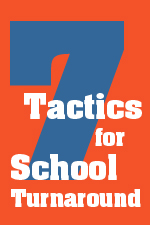Seven Timely Tactics for School Turnaround
By James Davis and Rebecca Smith Communicator April 2013, Volume 36, Issue 8 Serving as a principal in any school is a multi-faceted balancing act. Leading a low-performing school through a turnaround intensifies an administrator’s responsibilities.
By James Davis and Rebecca Smith
Communicator
April 2013, Volume 36, Issue 8
 Serving as a principal in any school is a multi-faceted balancing act. Leading a low-performing school through a turnaround intensifies an administrator’s responsibilities.
Serving as a principal in any school is a multi-faceted balancing act. Leading a low-performing school through a turnaround intensifies an administrator’s responsibilities.
But, there are tried-and-true tactics that school leaders can use to move schools forward in a meaningful, progressive manner. These effective ideas can aide principals and assistant principals in the process of transforming a school and positively impacting students’ and teachers’ lives.
Collect, analyze, and use data as a springboard for positive change. In order to change a school, it is important for practitioners to know what data is available, and feel comfortable working with it. At times, the amount of data available to school leaders can be overwhelming. While test scores are important, these are not the only data that should be used when working to transform a school. Data sources that should be examined when dealing with schools transformation include (but are not limited to):
- Test results;
- Report card grades;
- Student attendance;
- Teacher attendance;
- Discipline; and
- Walkthrough observations.
As data is collected and processed, it is important that it be shared in a way that positively impacts daily instruction and student achievement.
Never let anything get in the way of effective instruction. No two students—much less a full classroom of 22 or 26 or more students—learn in exactly the same way. Too often, teachers feel tied to a pacing guide and a textbook, and end up creating a blanket lesson plan that is “one-size-fits-all.”
A more effective practice is to first plan lesson concepts and themes, and then scaffold learning for students via differentiated levels of instruction or by offering students choices as part of the lesson. Using rubrics helps guide students and clarifies what is expected to be achieved as a result of the activity. Such lessons lead to greater levels of student engagement and active learning approaches via constructivist or experiential learning models.
Educate teachers about meaningful ways to use formative and summative assessments. Formative assessment has to be mastered by classroom teachers if we expect student achievement to increase. While summative assessments, such as quizzes and chapter tests, offer educational opportunities to students, they should not be used in isolation. Formative assessment (when used correctly) should guide instruction, and can be offered to students in a written or oral format, or in a group setting, if appropriate. The most important thing to remember with formative assessments is that they should be unique to each child and should provide them with the information needed to learn more, think effectively, and go beyond that which they were previously capable of.
Use prescriptive staff development in a one-on-one or small group setting. When it comes to professional development, one size does not fit all. Planning and implementing professional development that is individualized is an effective, positive way to turn a school around. Staff development opportunities have to be more prescriptive in nature; they should to occur in very small groups or, sometimes, one-on-one. With staff development that is specifically tailored to needs, requests, strengths, and weaknesses, participants feel appreciated. The focus is highly individualized, and the outcomes can be more easily monitored.
Cultivate a culturally responsive staff. It is important for teachers to keep in mind the diverse populations in their classrooms and to be responsive to those students’ needs. Impoverished children, for instance, may have developmental and academic delays or cognition and social-emotional disorders, as well as limited vocabulary acquisition. Teachers must also develop inviting, collaborative relationships with students’ families. Being mindful of differences and providing instructional materials that are aligned with students’ learning needs and preferences, creates relevance for lessons and builds students’ self-awareness and value in the larger context of society.
Never forget the importance of staff morale. In the midst of turning a school around, the days can become busy and overwhelming. It is important for a school administrator to keep staff morale at the forefront. Know the signs and dangers of teacher burnout. With the numerous updates and changes that can come along with improving instruction, implementing new processes, fine-tuning procedures, and keeping student-centered guiding principles in mind, morale can at times fall to the wayside. Never underestimate the power of a note, a card, a gift, a shout-out on the morning announcements, or a phone call.
Assess the physical components of your campus. Inviting environments can make all of the difference in the world. While academics, student progress, and safety will always take the lead, the physical characteristics of your campus and your individual classrooms play a large part it turning a school around as well.
Further, an appealing campus sends a positive message to each person that steps onto your campus, and those visitors can share good information about all that they saw and experienced. Encourage your staff to look at all visitors as public relations agents. You want every person to leave your school and “sell it” to others.
These timely tactics have been used in a variety of school settings, and primarily in low-performing schools. Together, they can lead to higher levels of student performance, higher staff morale, and a progressive atmosphere that permeates every aspect of a school..
James Davis is principal of Winecoff Elementary in Concord, North Carolina. Rebecca Smith is a retired assistant superintendent.
Copyright © 2013 National Association of Elementary School Principals. No part of the articles in NAESP magazines, newsletters, or website may be reproduced in any medium without the permission of the National Association of Elementary School Principals. For more information, view NAESP’s reprint policy.

